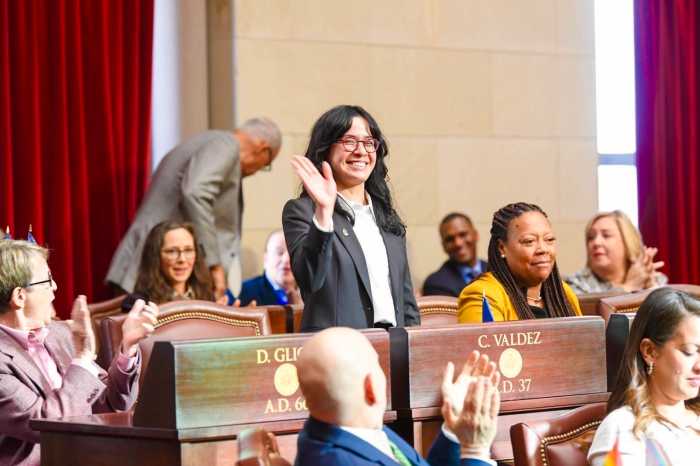Veterans of London’s Royal Ballet deconstruct classical vocabulary, musical form
Two hunky refugees from London’s Royal Ballet with an itch to expand their performing repertoire and the smarts to hire top-notch choreographers to create it for them formed George Piper Dances, which made its Joyce Theater debut November 4 through 9.
The thirty-something directors, Michael George Nunn and William Piper Trevitt, have a wacky British sense of humor, evidenced by their tongue-in-cheek company name and the excerpts from their video journal, projected as interludes between the three ballets on the program entitled “The Ballet Boyz.”
It’s fun to see rehearsal footage of dances we’re about to see performed live, and the video hijinks humanize the guys. But shaky “Blair Witch” camerawork and broad Monty Python-esque humor showing Nunn as “Rocky” in sweat clothes, running up the Philadelphia Museum stairs, and Trevitt as a CNN White House correspondent undermine the masterful choreography by William Forsythe, Christopher Wheeldon, and Russell Maliphant. The parody deserves its own show on TV, not in concert.
Set to Richard English’s score that sounds like falling rain, Maliphant’s “Torsion”—the closing work—gets off to a striking start, alternating between Nunn and Trevitt, trapped in squares of light, flailing their arms in repeated patterns. But this affectionate tribute to the rough-and-tumble comradeship between these dancing chums relies too heavily on standard contact-improvisation moves like rolling cartwheels over each other’s backs, handstands, repetitive mutual lifts, and knee spins in a big circle by Nunn, a la Russian folk dance—a circus trick not organic to the concept.
But the evening opens auspiciously with Forsythe’s 1984 “Steptext,” set to Bach’s “Chaconne No. 4 in D minor for solo violin,” an astute exercise in deconstructing classical ballet vocabulary and musical form. Its stretchy, juicy, contortionist movement in surprisingly abrupt encounters among three men and a woman evades narrative connotation, but makes total kinetic sense and is an electrifying technical display.
Before the house lights dim, the dance begins with Hubert Essakow, then Nunn, doing short arm gesture études that wrack and twist their bodies. A sudden, brief fragment of music ends each passage. Then, the four dance in pairs: Essakow and Nunn together opposite Trevitt and Monica Zamora. By turns each man has a duet with the woman, tilting her to unlikely angles, tossing her around like a loose-jointed rag doll, pulling her limbs asunder.
The lighting (also designed by Forsythe) suddenly blacks out in mid-phrase then returns to find the dancers continuing unfazed or discovering them in an entirely new configuration. Likewise, occasionally the music cuts off abruptly, pulling the plug on a movement phrase; or continues in a blackout, letting us know there’s more dancing to come.
In Christopher Wheeldon’s “Mesmerics” one can see the legacy of Forsythe’s choreographic innovations. Wheeldon—another alumnus of Royal Ballet, now resident choreographer of New York City Ballet—also creates his unique style by distending and expanding the classical lexicon; and he, too, in this work, introduces unexpected breaks in the Philip Glass cello music.
The dance for all five, including Oxana Panchenko, moves in a cycle, starting and ending with Nunn center-stage in a mysterious pool of light (by Michael Hulls), slicing large swaths through the air with his torso and arms. Along the way, Wheeldon treats us to some stunningly original partnering for two matching couples, and for two men with one woman; a remarkably fluent women’s duet in unison; and a recurring canon that increases in speed and density each time it recurs, until it reaches a kaleidoscopic climax with all five dancers, lined up front to rear, doing the identical phrase an eye blink apart, limbs flying sequentially in arcs like a Charles Edgerton stroboscopic photograph.
“The Ballet Boyz” rate kudos for matching dynamite dancing with—for a change—choreography of a stature equal to it.



































